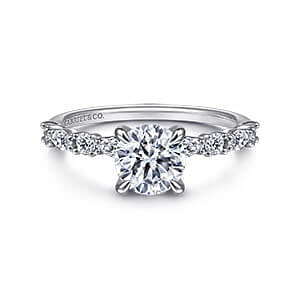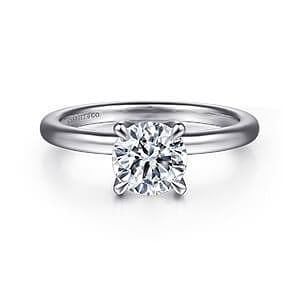How much to spend on an engagement ring? It's a question that leaves many grooms-to-be pondering as they prepare to pop the big question. When Elizabeth Taylor got engaged to Richard Burton for the second time, he gifted her a massive 33-carat white diamond – known then as the Krupp diamond – which she crafted into a ring. It was purchased specifically for her at an auction in 1968 for $307,000, a very high price for an engagement ring diamond at the time.
The ring has been synonymous with the ill-fated Taylor-Burton romance and remains a popular part of engagement folklore up until today. Famously renamed ‘Elizabeth Taylor’s Diamond’ after her passing, it was auctioned in 2011 for a whopping $8.8 million. More recently, billionaire James Parker outdid this figure by gifting his fiancée, Mariah Carey, a $10 million ring – a 35-carat emerald-cut diamond set in platinum.
While these are lovely engagement ring stories, most of us in the real world cannot pull out the stops to gift our significant other engagement rings worth millions. However, we still need to ensure that this jewelry piece is beautiful and significant to mark the most special day of our lives. The important question is, how much are you supposed to spend on an engagement ring in 2025?
How to Set a Budget for Your Engagement Ring: The Salary Rule
The salary rule has been one of the oldest ways (dating back to World War II) to budget for the best ring you can afford. The golden rule is to save up at least three months’ salary for an engagement ring. So, if you’re making $50,000 a year, spending $12,500 on an engagement ring is considered appropriate. However, many millennials and Gen-Zers on the verge of proposing or tying the knot want slightly more practical and affordable engagement and wedding ring options.
A tighter budget doesn’t mean your ring has to look any less gorgeous. So, the three-month salary rule has recently been replaced by the two-month salary rule. This ensures you can still purchase a great ring while making room for other financial commitments, loans, lifestyle expenses, and wedding costs. If you shop smart, you’ll have a great design that looks just as stunning as a higher-priced option.
Try out these engagement ring settings that cost between $1,500-$2,500. The prices mentioned here and on our website are for the setting, not the total ring. Note that most of the engagement rings at Gabriel & Co. are sold as settings without the center stone. Factor in an additional cost for the center stone (roughly $5,000 upwards) and have your beautiful diamond masterfully set separately in the design by an authorized Gabriel & Co. retailer.
This white and rose gold engagement ring is where romance meets a modern edge. A 1-carat round center stone takes the spotlight, held securely by 14K white gold prongs. The slim, straight shank in warm 14K rose gold adds a bold contrast, giving this design a fresh, stylish twist on a classic.
Another great option is the 0.32-carat oval halo diamond engagement ring. As the striking diamond halo boosts the brilliance of the oval-cut center stone, the setting is fashioned from 14k white gold with a slim, diamond-encrusted band.
Understanding the Average Costs of Engagement Rings
The cost of an engagement ring varies greatly based on factors like carat weight, cut, color, and clarity. The Knot's 2024 Jewelry & Engagement Study initially revealed that the average cost of an engagement ring was $5,200. However, in 2025, the average price has risen to $8,580, according to Estate Diamond Jewelry.
Larger carat weights naturally increase the cost, with prices rising significantly as carat size increases. For instance, according to StoneAlgo, a 1-carat diamond typically costs between $1,081 and $8,419, with an average price of around $3,835, depending on factors like cut, clarity, and color. Meanwhile, a 2-carat diamond can range from $8,000 to $40,000 or more.
To put it into perspective, one carat weighs approximately 200mg. Additionally, smaller diamonds totaling one carat are often less expensive than a single 1-carat stone due to the rarity of larger diamonds.
How Many Carats is the Average Engagement Ring Diamond?
Carat weight plays a significant role in determining the price of a ring. For example, the average carat weight for engagement rings in the UK and Europe is around 0.5–0.6 carats, while in the USA, it’s closer to 1–2 carats. Larger carat weights naturally increase the cost, with prices rising significantly as carat size increases.
When choosing the carat weight, budget is the first factor to consider. Engagement ring costs rise exponentially with carat size, but other elements—like finger size and diamond shape—can impact both price and visual appearance. For instance, elongated shapes like oval or pear diamonds may look larger than round or square ones of the same weight, offering a cost-effective way to maximize the diamond’s presence.
Round diamonds, however, remain the most popular choice, even though they typically cost more per carat due to their enduring appeal. Beyond carat weight, the other 3 Cs—cut, color, and clarity—also heavily influence the price of the ring.
These engagement ring settings at Gabriel & Co. cost between $2,500 and $4,000 and can accommodate a versatile selection of diamonds.
A round three-stone engagement ring setting in white gold can accommodate a 1-carat diamond that is 6.5mm. It is also available in platinum along with 14k and 18k yellow, rose, and white gold.
Yet another beautiful piece is this 14k white gold, round diamond engagement ring, which features a straight shank punctuated by alternating round and marquise diamonds. These diamonds weighing 0.46 carats add further beauty to the 1-carat center diamond, held firmly by four prongs.
Factors that Influence Engagement Ring Prices
What really drives the price of an engagement ring? It’s all in the details. We’ve covered the carat weight; let’s discuss other factors like the diamond’s color, cut, clarity, and setting. Each of these factors plays a big role in determining not just the cost but also the overall beauty of the ring. Let’s break it down.
Color Grades: Finding the Sweet Spot
Color grades for diamonds range from D to Z, and there’s quite a difference between them. If you look at grades that are next to each other, you may be unable to tell the difference, but grades farther apart exhibit a significantly noticeable difference. D is completely colorless and more expensive, while Z has a yellow tint and is far more accessible. The sweet spot for balancing price and quality is typically grades G through I.
Cut: The Key to Sparkle and Value
The quality of a diamond’s cut plays a critical role in determining its price and brilliance. A well-cut diamond reflects light beautifully, creating that signature sparkle everyone admires. Even with lower clarity or color grades, an excellent cut can refine the overall appearance of the diamond. Conversely, a poorly cut diamond will lack brilliance, even if it has high clarity and color grades. Investing in a high-quality cut ensures that your diamond shines its brightest, making it worth every penny.
Clarity: Prioritizing Flawlessness
Clarity refers to the visible flaws in a diamond, which can affect its overall appearance. Many people prioritize diamond clarity over size, opting for a near-flawless stone. The larger the diamond—typically above 2 carats—the more noticeable the flaws. To achieve a balance between quality and cost, aim for a clarity grade of VS (very slightly included) or VVS (very, very slightly included). If your budget allows, you can go for higher grades like Flawless (IF) or Flawless (F) clarity for ultimate perfection.
Setting and Design: The Details that Make a Difference
It’s not just the diamond that impacts the cost of an engagement ring—the setting and band design play a big role too. A classic solitaire setting might be more budget-friendly, but if you’re drawn to something more unique, like a halo design or intricate pavé details, be prepared to spend a bit more. The metal you choose matters as well—platinum tends to be pricier than gold because of its durability and rarity. And if you’re going for a custom design, the added craftsmanship can bump up the price. At the end of the day, these little details are what make the ring truly one-of-a-kind, so it’s worth investing in a style that feels just right.
If you’d like to splurge a bit on the setting, here are some enticing options from Gabriel & Co.
This showstopping bypass-style engagement ring is crafted in 14k white-rose gold while showcasing a pear-shaped diamond center stone. The swirling white gold shank is divided into several tapered tendrils, including one in contrasting 14k rose gold, each covered in glistening pavé diamonds. One tendril curls around the center stone, creating a halo and elevating it to a place of pride in this exceptional 1.04ct diamond ring.
Another luxurious piece is this 14k white gold and diamond engagement ring setting. A 1-carat center stone is highlighted against a band lined with alternating baguette and round diamonds. Thanks to its clean-lined silhouette, it is also perfect for pairing with stackables, the wedding band, anniversary, or eternity bands.
That said, there’s no need to worry. If you’d like to purchase a beautiful engagement ring setting, we have some great options under $1,500. Pick up these inspired designs that are easy on the pocket but extraordinary in their style impact.
With pared back embellishments, this 1-carat round-cut solitaire engagement ring is an ideal choice for the simple, classic woman. A hidden diamond choker adds .04 carats of sparkle to the center stone, while a 14k white gold shank completes this minimalist setting.
Another vintage-inspired engagement ring setting is this piece with a distinctive octagonal backdrop crafted in 14k white gold. This is designed to showcase your round-cut center stone to its best advantage. Triangular clusters of graduated accent diamonds flank the center stone. The tapered 14k yellow gold shank features vintage-inspired engraving and milgrain detailing.
What Are Some Other Alternatives to Diamonds?
You don’t have to break the bank and purchase only a diamond to fit one of our engagement ring settings. If a sapphire is good enough for the Duchess of Cambridge, it also works for us! Fortunately, 2022 has seen the return of color. Emeralds, topaz, and yellow diamonds have become popular center stones, thanks to celebrities like Katy Perry, Zoe Saldana, and Scarlett Johansson. Vintage styles like Art Deco and Edwardian are also making a strong comeback, so look beyond the tried and true.More than the lavish spending, it is the profoundness of emotions behind it that truly matters.
Should You Insure Your Engagement Ring?
If your ring is expensive enough and you’re not someone confident about handling your jewelry well, explore insurance. Ask pertinent questions to your insurance company on coverage, replacement, value assessment, and requirement of documents. Don’t pay more than 1%-2% of your ring’s cost as an insurance premium per annum.
For an excellent selection of ring settings to suit all budgets, head to Gabriel & Co. Our engagement ring settings are versatile, exquisitely crafted and can be customized in all metal variations – yellow gold, white gold, and rose gold.
Wrapping Things up
When it comes to choosing how much to spend on an engagement ring, the right amount is whatever feels right for you and your partner. Whether you go big or keep it simple, it’s the meaning and love behind the ring that truly matter.
For an excellent selection of ring settings to suit all budgets, head to Gabriel & Co. Our engagement ring settings are versatile, exquisitely crafted, and can be customized in all metal variations – yellow gold, white gold, and rose gold.









